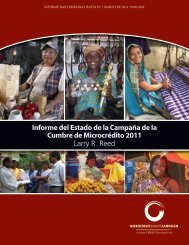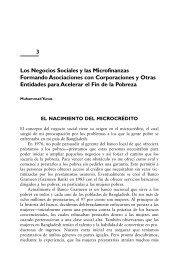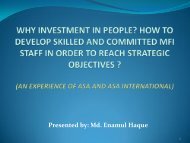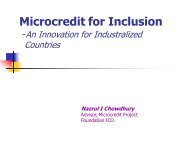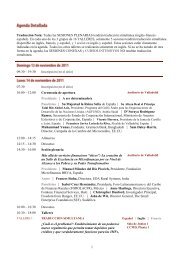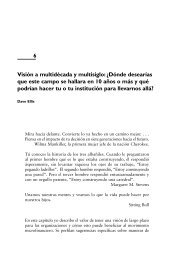Financial Literacy: A Step for Clients towards Financial Inclusion
Financial Literacy: A Step for Clients towards Financial Inclusion
Financial Literacy: A Step for Clients towards Financial Inclusion
You also want an ePaper? Increase the reach of your titles
YUMPU automatically turns print PDFs into web optimized ePapers that Google loves.
• User-friendly financial service providers catering to the low-income consumer,<br />
and;<br />
• Appropriate products and services.<br />
Thus building financial capability -- the combination of knowledge, skills and attitudes<br />
with the opportunities to apply them -- requires input from multiple sources including<br />
those that educate the consumer and those that sell the products. As a result, the<br />
responsibility <strong>for</strong> wise decisions regarding financial strategies and tools does not lie<br />
solely with the individual client. We would argue that building financial capabilities is<br />
two directional: while consumers have a responsibility to in<strong>for</strong>m themselves about the<br />
products they are ‘purchasing’, financial service providers have a responsibility to<br />
understand their market, and respond with a range of appropriate and af<strong>for</strong>dable services,<br />
including savings and credit accounts, payment services, insurance products and the<br />
ability to send and receive remittance payments cheaply. In short, the financial institution<br />
needs to meet the customer where they are, not solely on the institution’s terms. They<br />
need to apply principles of transparency in a way that facilitates clients’ decision-making,<br />
and verify assumptions about what clients understand and don’t understand about their<br />
products.<br />
In sum, financial capability is about bringing together in<strong>for</strong>med clients with appropriate<br />
products in the marketplace (Cohen, 2010). <strong>Financial</strong> education targets behavior change;<br />
done well, it provides opportunities <strong>for</strong> clients to practice new knowledge and skills.<br />
However, it is most effective when clients have real world opportunities to apply what<br />
they have learned over time. This is financial capability.<br />
Stakeholders<br />
Embracing the related goals of financial capability and financial inclusion requires a<br />
multi-stakeholder framework built around consumers, the financial services industry and<br />
government. <strong>Financial</strong> education is the nexus linking their interests in these common<br />
goals. Non-governmental and community-based organizations use it to promote<br />
livelihoods and asset building <strong>for</strong> the poor, integrating it into a range of activities that<br />
7




